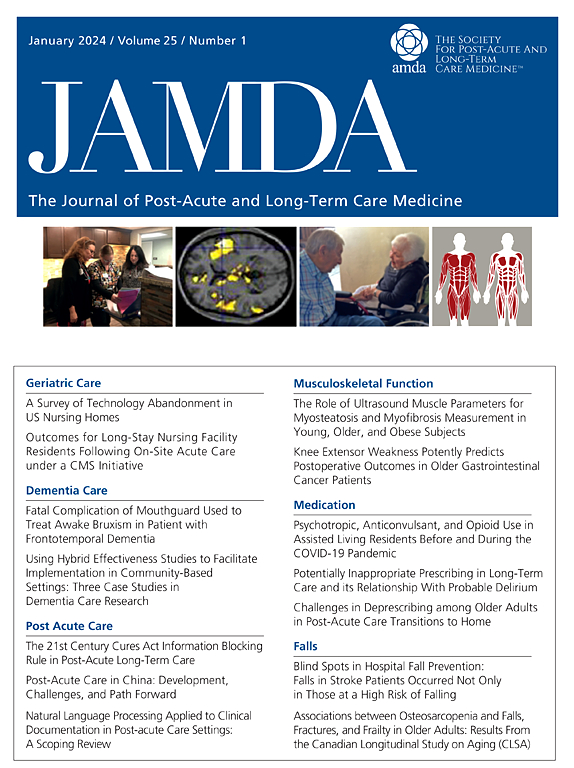骨盆计算机断层扫描与老年髋部骨折患者死亡率相关的性别特异性身体组成。
IF 4.2
2区 医学
Q2 GERIATRICS & GERONTOLOGY
Journal of the American Medical Directors Association
Pub Date : 2025-02-25
DOI:10.1016/j.jamda.2025.105502
引用次数: 0
摘要
目的:先前的研究表明,两性在髋部骨折后的身体组成和死亡风险方面存在显著差异。本研究旨在探讨接受髋部骨折手术的老年患者身体成分与死亡率之间的性别特异性关联。设计:双中心队列研究。环境和参与者:我们纳入了488例接受手术治疗的老年髋部骨折患者(年龄≥60岁)。方法:在术前盆腔计算机断层扫描(CT)上测量股骨上水平骨骼肌、皮下脂肪组织和肌间脂肪组织的截面积和衰减。采用按性别分层的Cox比例风险分析确定体成分与死亡率之间的关系。结果:队列平均年龄为76.2±8.7岁,女性312例(63.9%)。术后1年内死亡89例(18.2%)。女性患者皮下脂肪组织面积较大(SATA;中位数[四分位数间距],196.5 [160.1 ~ 228.5]vs 147.1 [111.3 ~ 181.1] cm2;P < 0.001)和下骨骼肌面积(SMA;187.2 [167.3 ~ 212.4] vs 255.5 [223.2 ~ 286.1] cm2;P < 0.001)。在性别分层的多变量分析中,女性的SATA(风险比[HR], 0.92;95%置信区间[CI], 0.86 ~ 0.97;P = 0.003)和男性SMA (HR, 0.93;95% ci, 0.86 ~ 1.00;P = 0.05)是1年死亡率的显著预测因子。将SATA或SMA纳入现有的诺丁汉髋部骨折评分(NHFS)中,在预测女性(曲线下面积[AUC], 0.70 vs 0.64, P = 0.11)或男性(AUC, 0.76 vs 0.71, P = 0.06)的1年死亡率方面分别略有改善。结论和意义:接受髋部骨折手术的老年女性皮下脂肪减少与死亡率相关,而男性肌肉量减少预示着死亡率。这些发现强调了在开发新的生物标志物和有效治疗策略时考虑性别二态性的重要性。本文章由计算机程序翻译,如有差异,请以英文原文为准。
Sex-Specific Body Composition Profile Determined by Pelvic Computed Tomography Associated with Mortality in Older Patients with Hip Fracture
Objectives
Previous research has demonstrated notable differences in body composition and mortality risk following hip fracture between sexes. This study aimed to investigate the sex-specific associations between body composition profile and mortality in older patients undergoing hip fracture surgery.
Design
Dual-center cohort study.
Setting and Participants
We included 488 older patients (aged ≥60 years) with hip fracture treated with surgery.
Methods
The cross-sectional area and attenuation of skeletal muscle, subcutaneous adipose tissue, and intermuscular adipose tissue at the the upper thigh level on preoperative pelvic computed tomography (CT) were measured. The relationship between body composition and mortality was determined using Cox proportional hazards analysis stratified by sex.
Results
The mean age of the cohort was 76.2 ± 8.7 years, and 312 (63.9%) were women. Within 1 year after surgery, 89 (18.2%) patients died. Female patients had greater subcutaneous adipose tissue area [SATA; median (interquartile range), 196.5 (160.1∼228.5) vs 147.1 (111.3∼181.1) cm2; P < .001] and lower skeletal muscle area [SMA; 187.2 (167.3∼212.4) vs 255.5 (223.2∼286.1) cm2; P < .001] compared with male patients. In the sex-stratified multivariable analyses, SATA in females [hazard ratio (HR), 0.92; 95% confidence interval (CI), 0.86∼0.97; P = .003] and SMA in men (HR, 0.93; 95% CI, 0.86∼1.00; P = .05) were significant predictors of 1-year mortality. Incorporation of SATA or SMA within the existing Nottingham Hip Fracture Score (NHFS) showed slightly improved performance in predicting 1-year mortality among women [area under the curve (AUC), 0.70 vs 0.64, P = .11] or men (AUC, 0.76 vs 0.71, P = .06), respectively.
Conclusions and Implications
Reduced subcutaneous adiposity is associated with mortality in older women undergoing hip fracture surgery, while reduced muscle mass predicts mortality in men. These findings highlight the importance of considering sexual dimorphism in the development of novel biomarkers and effective treatment strategies.
求助全文
通过发布文献求助,成功后即可免费获取论文全文。
去求助
来源期刊
CiteScore
11.10
自引率
6.60%
发文量
472
审稿时长
44 days
期刊介绍:
JAMDA, the official journal of AMDA - The Society for Post-Acute and Long-Term Care Medicine, is a leading peer-reviewed publication that offers practical information and research geared towards healthcare professionals in the post-acute and long-term care fields. It is also a valuable resource for policy-makers, organizational leaders, educators, and advocates.
The journal provides essential information for various healthcare professionals such as medical directors, attending physicians, nurses, consultant pharmacists, geriatric psychiatrists, nurse practitioners, physician assistants, physical and occupational therapists, social workers, and others involved in providing, overseeing, and promoting quality

 求助内容:
求助内容: 应助结果提醒方式:
应助结果提醒方式:


